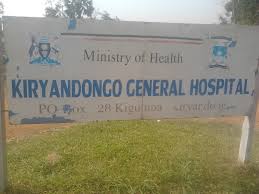Health officials, local leaders, and residents in Kiryandongo District are renewing calls for the government to upgrade Kiryandongo Hospital into a Highway Regional Referral Hospital, citing overwhelming patient numbers, limited staffing, and inadequate funding.
Constructed in the 1970s and rehabilitated in 2016, Kiryandongo Hospital serves a catchment area of about 500,000 people and receives close to 12,000 patients every quarter. The facility also attends to refugees living within the district.
However, both district leaders and hospital administrators say the facility remains underfunded and ill-equipped to meet the rising demand for healthcare services. Dr Godfrey Kisembo, the Medical Superintendent, says the overwhelming number of patients continues to strain the hospital’s limited resources, including drugs and medical supplies.
The hospital receives 800 million shillings annually for essential supplies, an amount Kisembo says is far below the 1.1 billion shillings needed each year to adequately provide quality services. He adds that most of the hospital beds are old and insufficient, while critical equipment requires urgent replacement.
Dr Kisembo notes that the hospital is also grappling with acute staff shortages, operating with only 169 workers out of the recommended 343, representing a staffing level of just 33 per cent.
He says the absence of a substantive surgeon remains a serious challenge, especially for emergency and trauma cases, arguing that the hospital’s elevation would attract more specialists and improve patient outcomes.
The hospital management and district leaders are now appealing to the Ministry of Health to elevate the facility to a regional hospital to enhance funding, infrastructure, and staffing.
Dr Kisembo explains that regional hospital status would come with specialised services such as medicine, surgery, paediatrics, obstetrics and gynaecology, psychiatry, and ophthalmology, allowing the facility to offer more comprehensive care.
Edith Aliguma, the LCV Chairperson of Kiryandongo District, says her office has repeatedly petitioned the government and even written to President Yoweri Museveni seeking intervention, but their appeals have not yielded results.
She argues that once upgraded, the hospital will qualify for increased funding, more medical supplies, and deployment of specialised health workers to match the district’s growing population. For many residents, the hospital’s challenges translate directly into long queues, congestion, and inadequate care.
Justine Thorach, a resident of Kiryandongo Town Council, says the high number of patients often forces some to sleep on the floor due to a shortage of beds.
Gilbert Ojur, another resident, adds that Kiryandongo Hospital deserves special attention because of its location along the busy Kampala-Gulu highway, where most accident victims are taken for first aid and treatment.
The call for elevation gained renewed urgency last week after a major road accident near Asili Farm in Kataleba Village, a few kilometres from Kiryandongo town, left 46 people dead and 67 others injured.
The hospital struggled to manage the influx of victims and had to refer all patients with serious injuries to facilities in Gulu and Kampala due to limited capacity and a lack of specialists.
Linos Ngompek, the Kibanda North Member of Parliament, said the tragedy tested the facility’s preparedness and reaffirmed the need for its elevation.
“The Kampala-Gulu highway is prone to accidents. As the Police work to minimise them, we appeal to the government to extend better facilities to Kiryandongo Hospital so it can respond effectively to such emergencies,” Ngompek said.
The Ministry of Health is yet to comment on the proposal to elevate Kiryandongo Hospital. Meanwhile, local leaders and residents remain hopeful that the government will heed their long-standing request, saying the upgrade would not only improve health service delivery in Kiryandongo but also strengthen Uganda’s emergency response system along one of the country’s busiest transport corridors.
***URN***

